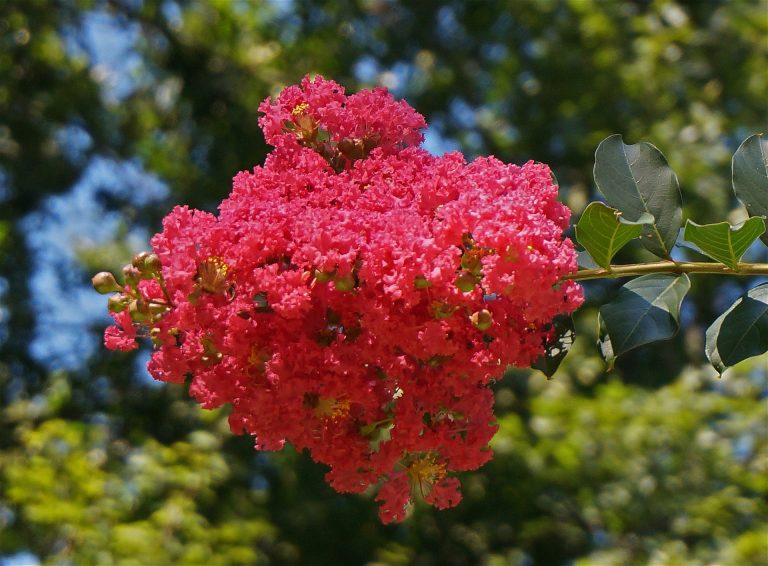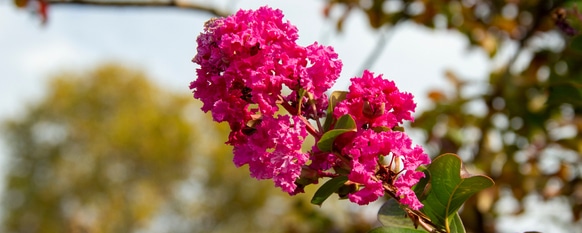When it comes to nutrients for crepe myrtles, you’ll want the best possible fertilizer. The difference between a good one and an average one is drastic. Don’t be swayed by marketing hype. Make sure you give your plants the best nutrients so that they can be as beautiful as possible.
Nothing says summer like beautiful crepe myrtles. They are easy to grow and bloom for so long that they have become one of the most popular plants in the south. The beauty of their flowers is undeniable.
If you like flowering plants, you may also want to consider growing siberian iris plants. They have stunning blooms.
That being said, even though they are easy to grow, you will want to use the highest quality fertilizer possible and want to make sure you are raising them properly. A healthy plant will be one that is more vibrant and will stay alive for years to come.
Keep learning about our top picks as well as a growing guide below.
Comparing Our Top 3 Recommendations

At A Glance
- Crepe Myrtle Plant FoodOUR TOP CHOICE
- Nelson’s Crepe Myrtle Granular Fertilizer
- Osmocote Smart-Release Plant Food (Green Bag)
- Bayer Advanced Protect and Feed Granules
- Scotts All Purpose Flower and Vegetable Continuous Release Plant Food
These are our top recommended products. They contain quality ingredients and have optimal N-P-K ratios. Make sure to read the guide below for more information.

Best Fertilizers for Crepe Myrtle
Crepe Myrtle Plant Food
N-P-K Ratio: 8-55-7
This plant food was specifically crafted with crepe myrtles in mind and is designed to nourish the health of plants, making them stronger overall. The formula contains a balanced blend of micronutrients that deliver the vitamins needed to grow evenly and steadily. The addition of a high level of phosphoric acid also encourages plants to bloom more frequently and may lead to larger, more colorful flowers. This product is formulated to release immediately in order to deliver nutrients quickly, but also has a slow-release component that nourishes the soil and plants for an extended period of time.
I highly recommend this brand if you have a more mature tree and you are having trouble with getting adequate blooms. The problem with products that are high in nitrogen content is that it will promote foliage growth in your trees rather than flower growth. This is a quality product will help you have the magnificent blooms.
BUY HERE: Crepe Myrtle Plant Food
Nelson’s Granular Fertilizer
N-P-K Ratio: 10-15-9
Nelson’s fertilizer is perfect for a wide variety of flowering trees, including crepe myrtles, crab apples, mountain laurels, and flowering pear trees. It contains a blend of nitrogen, potash, phosphate, and a range of minerals, including copper, zinc, iron, and manganese, all of which help to promote strong roots, stronger stems and branches, and better overall plant health. These minerals also ensure that flowering plants bloom more often and have larger, more vividly colored flowers. The product begins to nourish the soil immediately, but the blend also releases gradually as well, so plants receive nutrients for up to four months.
BUY HERE: Nelson’s Crepe Myrtle Granular Fertilizer
Osmocote Smart-Release Plant Food (Green Bag)
N-P-K Ratio: 14-14-14
Osmocote’s plant food is designed to work well on both vegetable and flowering plants, as it contains a blend of carefully balanced nutrients that help to promote larger, more colorful blooms. The formula is also gentle enough that it won’t burn the leaves or roots of plants. In addition, the granular plant food is easy to apply thanks to its water-soluble coating. It can be sprinkled near the base of the plants and mixed into the soil. During watering, the coating dissolves and the nutrients are released. This is also a slow-release formula, so plants will be fed for up to four months.
BUY HERE: Osmocote Smart-Release Plant Food (Green Bag)
Bayer Advanced Protect and Feed Granules
N-P-K Ratio: 2-1-1
Bayer’s feed granules are the perfect choice for flowering trees. This plant food contains nitrogen, phosphate, and potash, all of which enhance the quality of the soil, which in turn helps to nourish the plant’s roots. In addition, these granules help to protect plants from insects. The insecticides included will kill bugs such as Japanese beetles, woolly adelgids, scale, emerald ash borers, and psyllids. The granules also help to prevent new infestations. These granules both protect and feed the trees for up to a full year before another application is required.
BUY HERE: Bayer Advanced Protect and Feed Granules
Scotts All Purpose Flower and Vegetable Continuous Release Plant Food
N-P-K Ratio: 10-10-10
This plant food helps to enhance the soil by delivering a range of nutrients and minerals. In nutrient-rich soil, the roots of plants grow stronger and more steadily, creating a sturdy base. This leads to healthier plants and larger, more frequent flowers. In addition, this plant food from Scotts is gentle, so it won’t cause any burning or dehydration of the roots. The food is easy to use and can be raked directly into the soil. The slow-release formula nourishes the plants during every watering and ensures that they receive nutrients for up to two months.
BUY HERE: Scotts All Purpose Flower and Vegetable Continuous Release Plant Food

We recommend also checking out our salvia care guide for another flowering plant to consider growing in your garden.
Growing Guide
Well-Draining Soil
Crepe myrtle prefers well-draining loamy soils. If water stagnates at the root zone, it will make it prone to root disease and root rot.
The pH of the soil should remain in the 5.5-7.5 range.
Balanced N-P-K Ratio or Less Nitrogen
Crepe Myrtle grow most robustly with either balanced nutrient ratios or if you are having trouble with blooms, then you may want a fertilizer with less nitrogen to encourage flower growth rather than foliage growth.
You’ll want to look for products with a 1-1-1 ratio or else a product with a higher amount of phosphorous like 1-3-1 or 1-5-1. If you have a younger plant, you may want to aim for productss with more nitrogen. This will helps strengthen its root system.
When you are applying fertilizer, apply it around the base of the plant and make sure to water after applying.
Try to fertilize your crepe myrtle in the early spring when the tree starts to develop new buds.
When it is young, you may want to consider fertilizing it roughly 3-4 times in the spring and summer. For instance, you may want to consider adding nutrients in March, May, and July or August.
As your crepe myrtle matures, you can fertilize it less frequently or as I said above, consider using a fertilizer with lower nitrogen content and higher phosphorous content. This will help promote more blooms rather than more foliage. Our top pick is a product with a good nitrogen to phosphorous ratio.

Plant Spacing
When you are planting your crepe myrtle, make sure you are aware of the size that the tree should grow into. Obviously, the larger the mature plant will be, the more room it will need.
You want to take into consideration the room it will need to grow without affecting nearby buildings, power lines or walkways. By considering these things in advance, you can save yourself a lot of headache alter.
Generally speaking, medium-sized crepe myrtles will need 12-15 feet to grow.
Also remember to plant in a place where there is plenty of sun.
UGA cooperative extension recommends to water at the time of planting and also once per week (if there is no rainfall) for the first 2 months.
How to Grow in Cold Climates
Most crepe myrtles can survive winters in zone 7 (minimum winter temperature of about 0-10 degrees Fahrenheit). If you live in zone 5 or 6, then your plant will need some extra winter protection in order to survive.
To give it the extra protection it needs, you will want to wrap it in burlap to insulate it. You can also consider planting it near a south-facing or west facing stone wall which will help radiate some of the heat to your crepe myrtle. That being said, you will still want to wrap it with burlap.
The burlap should wrap all the way up the plant and not just around the base of the plant. This way the branches can be protected along with the root zone.
Burlap is a breathable material. Other materials such as plastic is a bad idea. The heat trapped by plastic on warm days can lead to plant damage and it is also not breathable.
Bottom Line
Again, I recommend buying the Crepe Myrtle Food, particularly if you’re having trouble with getting adequate blooms. Don’t make the mistake of buy any average fertilizer at your local gardening store. Many of them will simply not produce the same results. You cannot go wrong with any of the fertilizers above.
Happy Gardening!


I’ve just added Crepe Myrtle Food to my tree. It is about 15 years old and diseased. Leaves are turning yellowish and red while my other crepes are deep green. It’s perking up but what do I do about the disease.